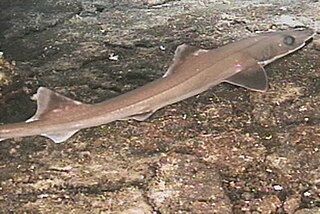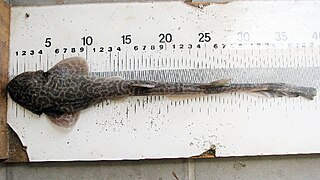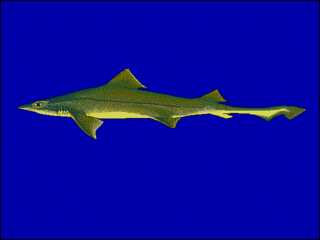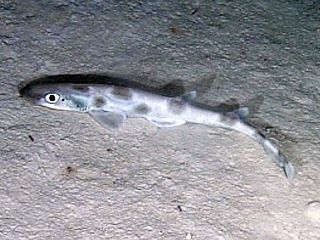
The dusky smooth-hound, also called the smooth dogfish or the dog shark, is a species of houndshark in the family Triakidae. This shark is an olive grey or brown in color, and may have shades of yellow or grayish white. Females live to 16 years and males have a lifespan of 10 years. M. canis was the first shark recognised to have viral infections.

Mustelus, also known as the smooth-hounds, is a genus of sharks in the family Triakidae. The name of the genus comes from the Latin word mustela, meaning weasel. It should not be confused with the genus name Mustela, which is used for weasels.

The slender smooth-hound or gollumshark is a species of ground shark in the family Pseudotriakidae. It is endemic to the waters around New Zealand, where it is usually found close to the bottom over the continental slope at depths of 300–600 m (980–1,970 ft). An extremely slim, plain brownish shark reaching 1.1 m (3.6 ft) in length, the slender smooth-hound can be identified by its broad, flattened head with a long, distinctively bell-shaped snout. Its mouth is angular with short furrows at the corners, and contains a very high number of tooth rows in both jaws. Its two dorsal fins are roughly equal in size.

The coral catshark is a species of catshark in the family Scyliorhinidae. It is common on shallow coral reefs across the Indo-West Pacific, from Pakistan to New Guinea. Reaching up to 70 cm (28 in) in length, the coral catshark has an extremely slender body, a short head and tail, and two dorsal fins that are angled backwards. It can be identified by the numerous black and white spots on its back, sides, and fins, which often merge to form horizontal bars. Furthermore, adult males have distinctively long and thin claspers.

The Izak catshark or simply Izak is a species of catshark, belonging to the family Scyliorhinidae, common off the coasts of South Africa and southern Namibia. It typically inhabits the outer continental shelf at depths of 100–300 m (330–980 ft), with the males found deeper than the females and juveniles. The Izak catshark has a short, wide, flattened head and a robust body tapering to a long, slender tail. It can be identified by its ornate color pattern of dark brown spots or reticulations and blotches on a light yellowish background, as well as by the enlarged dermal denticles over its pectoral fins and along its dorsal midline from the snout to the second dorsal fin. This species reaches 69 cm (27 in) in length, with the males larger than females.

The spotted houndshark, Triakis maculata, is a houndshark of the family Triakidae found in tropical waters in the eastern Pacific Ocean off the coast of South America. It usually grows to a length around 180 centimetres (71 in). The reproduction of this houndshark is ovoviviparous, with a litter of 14 pups being found in one female with a birth size of 30 to 40 centimetres. Their diet is believed to consist mainly of crustaceans.

The smooth lanternshark or slender lanternshark is a species of dogfish shark in the family Etmopteridae, found widely in the Atlantic and Pacific Oceans. It inhabits benthic environments at a depth of 274–1,000 m (899–3,281 ft), and pelagic environments at a depth of 0–708 m (0–2,323 ft). The smooth lanternshark forms a species group with the larger blurred lanternshark, both of which are distinguished from other members of their family by small, irregularly arranged dermal denticles with a truncated shape. This species has a slender, dark brown body with an indistinct black band on the sides over the pelvic fins, and reaches 50 cm (20 in) in length. This slow-growing, ovoviviparous shark feeds on smaller squid, fishes, and fish eggs. Smooth lanternsharks are often caught as bycatch in eastern Atlantic and Japanese commercial fisheries. The International Union for Conservation of Nature (IUCN) has evaluated this species as of Least Concern because of its wide distribution and limited threats.

The starry smooth-hound is a houndshark of the family Triakidae. It is found on the continental shelves of the northeast Atlantic, between latitudes 61 and 16° N, from the surface to a depth of 200 m (660 ft).

The spotless smooth-hound is a species of houndshark, in the family Triakidae, found on the continental shelves of the northwest Pacific, between latitudes 40° N and 11° N, from the surface to a depth of 300 m. It can grow to a length of up to 1 m.

The sicklefin smooth-hound is a houndshark of the family Triakidae. Even some species look similar to Carcharhinus family, mustelus second dorsal fin is much bigger. It is found on the continental shelves of the eastern Pacific, between latitudes 33° N and 7° N. The difference between sharptooth smooth-hound and mustelus lunulatus, is that the lunulatus second dorsal fin origin far in advance of the anal fin. It can reach a length of up to 1.7 m. The reproduction of this shark is ovoviviparous.

The speckled smooth-hound is a houndshark of the family Triakidae. It is found on the continental shelf of the eastern Pacific, between latitudes 0° and 54° S, at depths between 16 and 50 m. It can reach a length of 130 cm (51 in). Collectively with certain other species of shark, it is known as "tollo".

The Gulf smooth-hound is a houndshark of the family Triakidae, found on the continental shelves of the tropical western central Atlantic. The reproduction of this houndshark is placental viviparous.

The humpback smooth-hound is a species of houndshark and a part of the family Triakidae.The most noticeable difference between Mustelus whitneyi and its relatives, is the slight curvature, causing a "humpback" appearance located in front of its primary dorsal fin. It is found on the continental shelves of the tropical southeast Pacific, from Peru to southern Chile, between latitudes 3° S and 54° S. These sharks are demersal feeders but range from depths between 15 and 210 metres. Humpback smooth-hound sharks are small sharks, reaching a maximum size of 118cm in total length. Mustelus whitneyi typically feed on teleosts and invertebrates in the benthic and pelagic ecosystems, most important prey being the peruvian anchovy. These humpback smooth-hound sharks are placental viviparious sharks, meaning that the embryo forms inside the mother tethered by the placental cord. The threats currently causing population decline to humpback smooth-hound sharks surround issues with local fisheries and management.

The whitesaddled catshark is a species of catshark, and part of the family Scyliorhinidae. It is found on the upper continental slope of the western central Atlantic Ocean, off the coasts of Honduras, Panama and Colombia, between latitudes 22° N and 9° N, at depths between 274 and 457 m. It can grow to a length of 47 cm (19 in). The reproduction of this catshark is oviparous but otherwise, little is known about its biology.

The boa catshark is a catshark of the family Scyliorhinidae. It is found on the continental shelves and insular slopes of the Caribbean Sea and the Gulf of Mexico, between latitudes 20° N and 9° N, at depths between 330 and 675 m. It can grow up to a length of 54 cm. The reproduction of this catshark is oviparous.

The roughtail catshark or marbled catshark is a common species of catshark, part of the family Scyliorhinidae. It is found at a depth of 36–702 m (118–2,303 ft) in the northwestern Atlantic Ocean, the Gulf of Mexico, and the Caribbean Sea, from North Carolina to Costa Rica. Individuals of different sexes and ages are segregated to some degree. A small species not exceeding 33 cm (13 in) in length, the roughtail catshark has a slender body with a marbled color pattern of dark saddles and spots, and a prominent crest of enlarged dermal denticles along the dorsal edge of its caudal fin. This species feeds mainly on shrimp and is oviparous. It is caught incidentally in shrimp trawls, though trawl fisheries within its range mostly do not operate at the depths it inhabits. As a result, the International Union for Conservation of Nature has listed it under Least Concern.

The Australian grey smooth-hound or also known as the grey gummy shark is a species of houndshark classified under the large family Triakidae. It is one of the twenty-eight species belonging to the genus Mustelus, which are often small in length. While members of the genus Mustelus may be found globally in tropical and temperate waters, the grey gummy shark in particular is native to the Pacific Ocean and Indian Ocean waters surrounding Australia and is particularly widespread in deep coastal waters. The grey gummy shark is known to be a viviparous species and gives birth to live young. With little data available, it is regarded to have a relatively stable population and possesses little threat to humans.

Raja stellulata, commonly known as the Pacific starry skate, rock skate, prickly skate, or starry skate, is a species of cartilaginous fish in the family Rajidae. It is found on rocky bottoms at 18–982 m depths in the Northeast and Eastern Central Pacific, from Coronado Bank in northern Baja California in Mexico to Barkley Sound in British Columbia, Canada. Females reach a maximum total length of 76.1 cm and a maximum age of 15 years, while males can be up to 71.7 cm long and live up to 14 years; the total length at birth is 15.5–22.5 cm. This skate prefers cold water with a temperature of 4.1–11.6°C.

The rough ray is a Mediterranean ray species of the Rajidae family described by Delaroche in 1809.

The Andaman smooth-hound is a type of smooth-hound of the family Triakidae, found in Eastern Indian Ocean. This benthopelagic shark inhabits the depths of 50–100 m (160–330 ft).






















